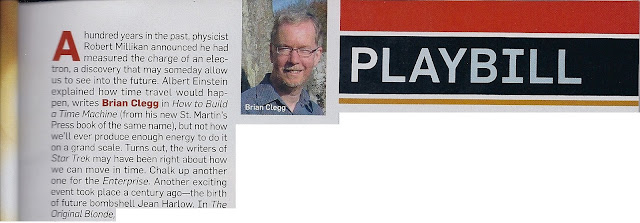Don't get too excited now, but my photograph has appeared in Playboy magazine. (December issue if you're interested.) Here it is:
 Okay, not necessarily what you were thinking of, but that's definitely my photo and you can take my word for it that it's a cutting from Playboy, specifically the edition shown here.
Okay, not necessarily what you were thinking of, but that's definitely my photo and you can take my word for it that it's a cutting from Playboy, specifically the edition shown here.
I must confess that I have never bought a copy of Playboy (no, honestly), so I was always very dubious about those people who claimed that they only bought it for the articles - but I must admit there was a lot more text in it than there were dubious photographs (and they were relatively tasteful). And, of course, all the great writers had pieces published in this august journal.
As the 'playbill' intro suggests, what is featured is a piece adapted from How to Build a Time Machine, so if you're a regular Playboy reader (for the articles, of course), you can get a bit of a preview of some of the material on offer. They've done quite a dramatic job with the opening spread, as you'll see with part of it below (though the real thing looks more impressive). I don't know if they have different versions of the magazine worldwide, but it's certainly in the US edition.
 Okay, not necessarily what you were thinking of, but that's definitely my photo and you can take my word for it that it's a cutting from Playboy, specifically the edition shown here.
Okay, not necessarily what you were thinking of, but that's definitely my photo and you can take my word for it that it's a cutting from Playboy, specifically the edition shown here.I must confess that I have never bought a copy of Playboy (no, honestly), so I was always very dubious about those people who claimed that they only bought it for the articles - but I must admit there was a lot more text in it than there were dubious photographs (and they were relatively tasteful). And, of course, all the great writers had pieces published in this august journal.
As the 'playbill' intro suggests, what is featured is a piece adapted from How to Build a Time Machine, so if you're a regular Playboy reader (for the articles, of course), you can get a bit of a preview of some of the material on offer. They've done quite a dramatic job with the opening spread, as you'll see with part of it below (though the real thing looks more impressive). I don't know if they have different versions of the magazine worldwide, but it's certainly in the US edition.



I think the articles are easily the best part Brian - proof positive that science is sexy
ReplyDeleteThis is just so damn cool - congratulations! Where do you go from here, Brian? What could possibly be left to aspire to?!
ReplyDeleteThanks, Tania! But there's plenty left to aim for!
ReplyDelete